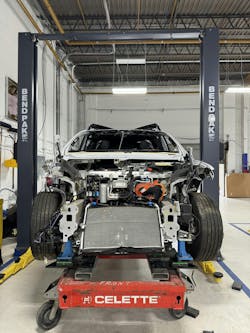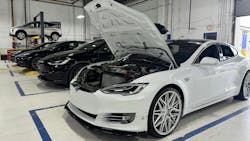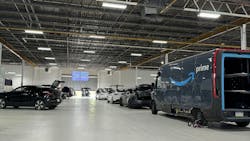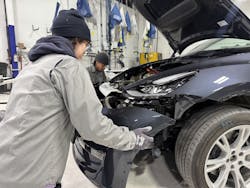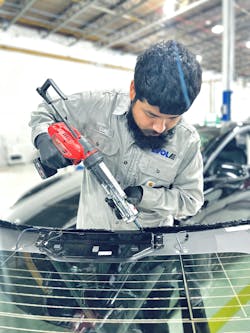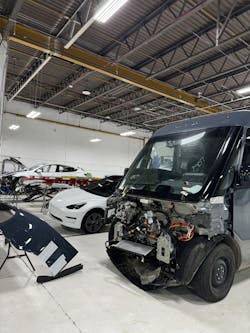It doesn’t take much time for a “new fad” to become standard, and some people in the automotive industry believe we’re seeing that with electric vehicles.
When the original iPhone was released in 2007, a lot of people were unsure about what exactly the device was.
Smartphones weren’t new – there were about 22 million sold in the year before the iPhone’s launch – but the market-leading Nokia E62 and BlackBerry still resembled traditional cell phones. The iPhone, on the other hand, didn’t look like a phone. Instead, it resembled something more like Apple’s popular iPod line of MP3 music-playing devices.
So was it just a phone? Could you listen to music on it? Why did it need a touch screen, and where is the keyboard? Those questions seem silly now nearly 20 years later, but they were asked often of the device. Belief in the iPhone’s ability to draw a large audience was slim in 2007.
Steve Ballmer, CEO of Microsoft at the time of iPhone’s launch, was among the skeptics. In an interview with USA Today in April 2007, Ballmer said, “There’s no chance that the iPhone is going to get any significant market share,” calling Apple “edgy” and saying they would be lucky to get 2 or 3 percent of the total market share on cell phones.
To put it lightly, that take didn’t age well.
In its first year, the iPhone sold around 6 million units. Fast-forward to 2025, and nearly 1.4 billion people use iPhones, representing nearly 22 percent of total smartphone usage in the world.
Though it may seem like the iPhone’s meteoric rise to global phenomenon status was inevitable looking back, many people discounted it during its early years. Every year, though, more and more people began buying the Apple cellular device. The trend gained momentum, and the trend became the status quo.
EVs during their first few years in the mainstream market have seen a similar cult following that the iPhone had back when it first released. Though we have yet to see just how far the electrification trend will go, EVs have gained a foothold in the global car parc, and their total sales keep increasing year over year.
John Sweigart has seen a lot of trends come and go in his nearly 30 years in the automotive business. He’s worked in almost every branch of automotive repair imaginable, from collision centers and ride share operations to industry publications. For nearly three years from 2016 to 2018, he also worked for Tesla, eventually becoming their global service director. He’s become an EV repair expert and one of the leading authorities on EVs in the collision aftermarket.
And he thinks EVs are here to stay.
“Obviously, the adoption of EVs, the rate of acceleration is far greater than what was predicted early on. We've passed that market share,” Sweigart says. “I think 5 percent is sort of the magic number where it's not a fluke, so there's enough evidence that this is actually happening and it's not some kind of fluky event. It's a viable product for the market. There are way more of these things on the road than ever before.”
There were more than 4 million EVs on the road in the U.S. in 2024, which is double the number that were on the road the previous two years. New EVs accounted for almost 10 percent of new vehicle registrations in 2024, and some experts predict anywhere from 30 to 40 million EVs on the road by 2030.
Sooner or later, you’re going to start seeing EVs show up in your shop — if you haven’t already — and Sweigart says to be prepared, you must think about collision repair in a whole different way.
“(EV and ICE repair are) just not the same thing, and the sooner we pay attention to that that the better this gets,” Sweigart says. “It's going to require wholesale radical change of how we think about everything.”
Time to Evolve
Evolve Electric Vehicle Specialists in New Castle, Delaware, was founded in 2022 as a solution to fill the gap in EV repair services caused by the divide between what is required to fix ICE and EV technologies and systems.
On its website, Evolve says it takes an average shop around 45 days to start an EV repair and around 37 days to actually perform the work. At Evolve, it takes less than a quarter of the time, with a two-day wait and a 10-day turnaround.
Sweigart is the CEO of Evolve, and he says they’re able to achieve this level of efficiency in EV repair because they’ve completely rebuilt from the ground up the way they look at vehicle repair.
“That's why we don't call ourselves a body shop. We're an electric vehicle support business,” Sweigart says. “Even the name, Evolve, shows that we’re really trying to push that we’re different.”
You don’t have to look too far to notice the difference. The shop floor at Evolve has been laid out like an assembly line in a factory instead of a traditional bay system. Big TV screens in each station point to what’s next, who should be where, and provide any additional information in an effort to make sure that team members know what they’re doing at all times.
Sweigart says this model was based off the (lean) Toyota Production System, and it’s a system that prioritizes continuous improvement by quickly identifying problem areas. When a vehicle is moving through Evolve’s repair “assembly line,” Sweigart’s team is constantly looking for areas where the process gets bogged down to make improvements.
The point isn’t to avoid interruptions in the workflow. Instead, when an interruption inevitably comes up, it provides an opportunity for his team to find a solution and improve.
“In creating our workflow, we’ve thought through the logical sequence of events taking a customer from ‘help me’ all the way through ‘thank you,’” Sweigart says. “We then sort out the best-known way to perform each one of these steps and standardize the work in that step. We then right-size the work in each step so that we have a chance of creating flow of work between all steps from ‘help me’ to ‘thank you.’”
One primary method in which Evolve optimizes that workflow is in how it manages parts inventories.
Normal parts estimates aren’t as efficient because EV manufacturers such as Tesla don’t have dealer networks to distribute parts; any order for a component goes directly through the company’s supply chain, and that order competes with the manufacturer’s own assembly plants.
To combat this, Sweigart says Evolve keeps a stock of parts on-hand at all times. Though it’s not an exact science, he says the process follows some basics of supply chain management.
“In terms of what we stock and when we re-order, it’s roughly based on parts that we’ve experienced lead-time issues with,” he says. “We tend to stock the high-moving parts as well as a few of the one-off type parts that can cause massive delays such as control modules or wiring harnesses.”
For example, Sweigart says if they use one type of part three times a week and it typically takes three weeks to get that part, they’ll set a minimum order of nine so they’ll always have that part on hand.
“It’s certainly a different type of expense than what traditional collision repairers are used to, and there’s a real cost when you do something like this,” Sweigart says. “We believe the benefit comes in cycle time reduction, which we believe leads to greater customer satisfaction - which leads to more volume.”
Another key way to solve problems as they arise is to have technicians who are trained not only to identify problems, but who are also empowered to come up with solutions. That, Sweigart says, is one of the foundational principles of Evolve’s training programs.
Evolve is certified by Tesla and Rivian, but its certifications and training for its technicians go far beyond standard OEM procedures. The shop says it can repair any make and model of electric vehicle, and Sweigart says his team has developed around 90 percent of its training internally.
“While we do utilize the training that is available through the manufacturer and other sources like I-CAR, because of the nature of our operating model, we only need to train technicians for specific functions and specific areas.”
Sweigart likens Evolve’s training process to teaching someone how to play the piano – it’s more about training for the general skill than it is for a specific type of car.
“Once they understand (the basics) of how to play, we can put the sheet music down for almost any song,” Sweigart says. “We don’t have to train them to play every song in the songbook.”
If a technician understands how to calibrate a radar in general, they should be able to figure out how to calibrate a radar on most vehicles with the proper OEM repair procedure and repetition. Though systems will be different depending on the vehicle – for example, calibrating a radar on a Kia will look slightly different than on a Tesla – the basic principle is mostly the same.
Through this training model, technicians are able to slot into the assembly line process right away and contribute to the shop’s productivity. From there, Sweigart says the goal is to have them learn all steps of the process at all levels, which means they become more reliable and useful.
“The people in each step are trained and certified in not only how to do that stuff, but ultimately in how to improve that step. So, in no circumstance will you see that traditional “one man one car” work processing, which delivers a very inconsistent level of quality and rate,” Sweigart says. “It’s what Henry Ford did to automobile manufacturing, just better.”
Striving for Constant Improvement
In a way, Evolve is the iPhone of the EV collision repair industry – ahead of its time, but also possibly a harbinger of larger changes coming in the not-too-distant future. Sweigart says more shops are going to need to adopt similar philosophies to handle the growing wave of EVs, which at this point seem to be inevitable.
“As we adopt EV and self-driving more and more, we're going to need an understanding in the industry,” Sweigart says. “We can't be the only voice. The more people out there really being transparent and honest and talking about the problems, the better it's going to be for all of us.”
Each step in Evolve’s process is essential to keep cycle times low. None of them is easy to implement, either, which is why Sweigart and his team developed Evolve from the ground up instead of trying to overlay one or two of the changes onto an existing shop. It would be almost impossible for an existing shop to overlay an Evolve-style workflow onto their current operation, especially if it’s working on both EVs and ICEs.
However, focusing on educating your techs and yourself, as well as constantly reflecting on and improving your processes, is a great way to keep evolving to handle EV repairs.
“Spend as much time as you can diagnosing the problems yourself. You have to dig deep on every issue and go down every rabbit hole when it comes to understanding what’s causing a certain condition,” he says. “If you’re not prepared to do this digital work yourself, you’re going to wind up spending a ridiculous amount of time and money with third-party sublet companies and all that comes with that.”
EVs aren’t going anywhere, and if your shop is going to handle repairing them effectively, Sweigart says a different perspective on process improvement isn’t just helpful – it’s essential.
“If you’re going to live in a world of continuous problems, which obviously you must do if you’re going to live in a world of continuous improvement, you must understand which problem you should fix today,” Sweigart says. “Otherwise, you live in a world of hell surrounded by nothing but problems.”
About the Author

Noah Brown
Noah Brown is a freelance writer and former senior digital editor for 10 Missions Media, where he facilitated multimedia production several of the company's publications.

